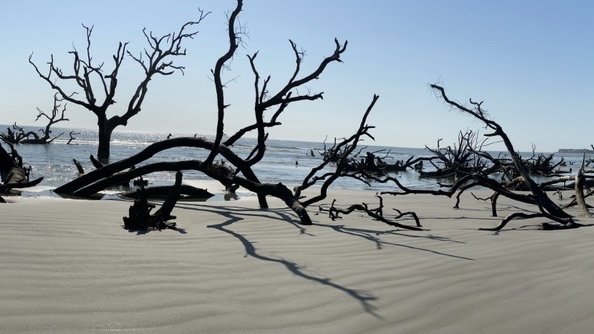National Climate Assessment Presents Science and Solutions In Response to Global Warming
Recent bouts of flash flooding in the Hudson Valley exemplify increased intense precipitation trends in the Northeast region, as described by the Fifth National Climate Assessment. "Metro-North Railroad Storm Conditions on Harlem Line" by MTAPhotos is licensed under CC BY 2.0.
When it comes to the climate crisis, doom and gloom can often permeate the atmosphere. In contrast, the Fifth National Climate Assessment intends to paint a different picture in which a holistic evaluation of global warming paves the way for further climate action.
This year’s report, released on Nov. 14, spares no region of the U.S. from climate change, with warmer night temperatures and heavier precipitation events occurring everywhere in the country.
The nation now undergoes a billion-dollar climate or weather disaster every three weeks. And following the unprecedented events of a sweltering summer, remembered most vividly in the Northeast for the Canadian wildfire smoke-tinted skies, 2023 is on track to be the warmest year ever on record.
“It is happening everywhere now, so they were very deliberate to call out impacts in every region,” said Jessica Boscarino, associate professor of political science at Marist College.
According to NCA5, yearly U.S. greenhouse gas emissions decreased by 12% from 2005 to 2019, mainly fueled by reduced coal use. Even so, such a promising statistic would have to come about every single year to achieve net zero carbon dioxide emissions, in which the amount of carbon dioxide removed from the atmosphere surpasses the amount emitted. On a global scale, net zero emissions must occur by 2050 to stay within the 1.5 degrees Celsius warming limit.
As the world convened in the United Arab Emirates to continue the climate conversation at the 28th annual United Nations Climate Change Conference, which finished in December with a more generic pledge to “transition away from fossil fuels,” NCA5 shines a spotlight on the country heating up 60% faster than the planet as a whole since 1970.
Although the report acknowledges an expansion in climate adaptation and mitigation actions since the publication of the Fourth National Climate Assessment in 2018, it concludes that greater efforts are needed to cut more emissions down at a faster pace — which is possible.
“There’s some optimism as in not only remedy, but remedy while getting ready for what’s to come ahead,” said Jose Torres, visiting lecturer of environmental science at Marist. “Whether we like it or not, things will be coming, so we need to be ready.”
Putting it together
The U.S. Global Change Research Program, composed of 14 federal member agencies, releases a new national climate assessment every four years, as is required under a Congress mandate from 1990.
A Federal Steering Committee for the report was established in February 2020, with a first draft of NCA5 completed two years later. Public comments and virtual engagement workshops, along with tribal consultations and an external peer review by the National Academies of Sciences, Engineering and Medicine, also helped inform the assessment’s final iteration.
According to Stephen Hamilton, senior scientist at the Cary Institute of Ecosystem Studies and an author on the Ecosystems, Ecosystem Services and Biodiversity chapter, collaboration was a key ingredient in the recipe for report success. After being asked to contribute his freshwater expertise, he and fellow chapter group members held recorded Zoom meetings over many months to review drafts and figures.
“It was all people that I’ve never worked with before, but they all had different specialties in the ecosystem field, so it was a really interesting experience to hear people’s views and knowledge on all these different topics,” said Hamilton.
When the Fourth National Climate Assessment was released in 2018, then-President Donald Trump said he did not believe it. In contrast, President Joe Biden announced over $6 billion in climate resilience investments the day NCA5 was published. And although the report does not offer suggestions for environmental policymaking, it can still inform the country’s conversations around climate.
“This might not be the thing that makes a specific action happen or not, but it’s part of that body of evidence, and I want it to be talked about all the time,” said Boscarino.
Within its 32 chapters, NCA5 offers a comprehensive scientific review of global warming in the U.S. — one could call it a ‘State of the Climate Union’ by scientists. And the facts provided speak for themselves, from land to sea.
Sea level rise killed these coastal trees in South Carolina, producing a ghost forest. Credit: Stephen Hamilton
Impacts on humans and habitats
As warm ocean water expands and glaciers and ice sheets melt, a possibility of seven feet in sea level rise by the year 2100 threatens to displace the 40% of Americans who live along the coasts. In the Northeast, home to the top 1% of the heaviest precipitation events in the country, warmer surface ocean waters fuel slower-moving storms, heavier rainfall and increased storm surge.
Gov. Kathy Hochul requested federal funding for parts of lower New York State in response to emergency-level flooding in late September. And no one could forget the eight consecutive weekends of rain this past fall, which caused a mudslide to disrupt Amtrak and Metro-North train service.
“That actually sets the base level higher so that storms can push flooding off the sea water or freshwater further inland than it otherwise would,” said Hamilton.
But people are not the only ones whose lives climate change disrupts, as the ecosystems that support us cannot support themselves. Warmer temperatures create mismatches in the timing of biological events, such as the leaves of “stressed” trees that skipped the usually colorful fall foliage season. Across the U.S., biodiversity loss remains an existential threat, with 40% of animals and 34% of plants at risk of extinction, while invasive species present a newfound hazard as their range shifts farther north in response to the changing climate.
Hamilton noted that freshwater sources are especially susceptible to invasions, such as the zebra mussels in the Hudson River, which have disturbed the food chain by reducing amounts of phytoplankton and zooplankton. Invasive plants and weeds, like the dense Eurasian watermilfoil taking North America by storm, pose an additional peril.
“Aquatic plants aren’t bad in and of themselves, but if they grow too thickly and too fast, then they interfere with people’s use of water bodies,” said Hamilton. “They can also smother out the native life, and it becomes kind of a biological desert in a way.”
Prioritizing equity and inclusion
Climate change reduces air quality, food security and physical health for all human beings — but it does affect some more than others. This year’s national climate assessment is the first to dedicate an entire chapter to the disproportionate impacts of global warming on frontline communities, defined more broadly as the issue of environmental justice.
“If you really want to talk about it as a country or as a state, you cannot separate the population,” said Torres.
According to the report, low-income individuals and people of color are highly exposed to extreme events by living in areas that lack infrastructure or have heightened hazards. Such is the case with Newburgh, New York, a designated disadvantaged community in Orange County, still waiting for a faster cleanup of toxic PFAS chemical contamination in its waterways.
Even more so, Black Americans succumb to heat-related diseases twice as often as the general population, which is further exacerbated by their likelihood to reside in less energy-efficient homes. At the same time, low-income neighborhoods are warmer on average — in particular, buildings and roads absorb more warmth and turn urban areas into heat islands.
“Sooner or later, all of us are going to be affected, and it’s a broad statement, saying it’s not fair. But in reality, we have to do right,” said Torres.
After navigating a history of land disenfranchisement from the U.S. government, Indigenous peoples are also exposed more greatly to climate change. Heatwaves interrupt traditional ceremonies, wildfires stake a claim to culturally significant sites and animal food sources shift their range elsewhere. Since Indigenous communities often lack eligibility for federal funding, it makes these losses all the more impactful.
Kelp forests, dense groupings of brown algae frequent on the west coast, are one example of the blue carbon that can help mitigate climate change. Credit: Oleksandr Sushko on Unsplash.
Living in the new abnormal
With current environmental conditions far from ideal, NCA5 leaves the public with a simple premise: a better future is possible — if the right motivation and efforts transform national society as we know it.
“I see it as a shift from previous climate assessments, which just used to talk about this line in the sand like this is the moment when there’s a point of no return,” said Boscarino. “And what I appreciated about this one was saying that anything we can do to lessen the amount of warming is going to be helpful.”
Adapting to the fully expected outcomes of climate change in a less incremental and more transformative manner requires a proactive response instead of a reactive one. From a climate justice standpoint, this might include interviewing Indigenous leaders with knowledge about biodiverse crops or adding green infrastructure and public cooling centers to disadvantaged communities.
According to the report, New York has engaged in more climate adaptation actions than any other state in the Northeast region through 2018 and since then. This is in no small part due to the Climate Leadership and Community Protection Act, which aims to cut greenhouse gas emissions at a rate of 40% by 2030. In addition, programs like the Cornell Cooperative Extension and Climate Smart Community Grants educate individuals and municipalities in climate resiliency efforts.
“As the report makes clear, even if we stopped emitting all greenhouse gasses tomorrow, we’re going to be living with the effects for a very long time. We must adapt, and we must become resilient,” said Hamilton.
Working in tandem with adaptation, mitigating climate change by reducing overall emissions is an equally effective strategy.
Designing a sustainable future
With wind and solar power costs declining by 70% and 90%, respectively, over the past 10 years, renewable energy is in high national demand, along with jobs in the decarbonization sector replacing those in the fossil fuel industry. Since transportation stands as one of the leading greenhouse gas emitters in the nation, shifting to increased use of electric vehicles and public transportation remains another recommended task. Carbon capture technologies are also on the rise — last month, the first commercial plant in the U.S. designed to absorb carbon dioxide from the atmosphere opened in California.
The assessment does denote a special feature to blue carbon, which refers to the carbon capture potential of water-based ecosystems. In contrast to the green carbon of forests on land, coastal and marine areas can absorb carbon dioxide faster than their terrestrial counterparts, providing a vast potential to be tapped that has only recently been realized.
“Traditionally, there has been the green economy. But the green economy also included things underwater. In 2012, they became separate things, and now, it’s pretty much the same goals, but while taking good care of underwater domains,” said Torres.
Despite the wide variety of solutions outlined by NCA5, most Americans believe the federal government is not doing enough to address the climate crisis. But somewhere in between adjusting for the present and accounting for the future, the assessment provides a chance to focus on the silver lining.
“My hope for sweeping ambitious national level climate policy is not great right now,” said Boscarino. “But that being said, it doesn’t mean I’m hopeless because I’m seeing lots of smaller actions that are adding up to bigger impacts.”


